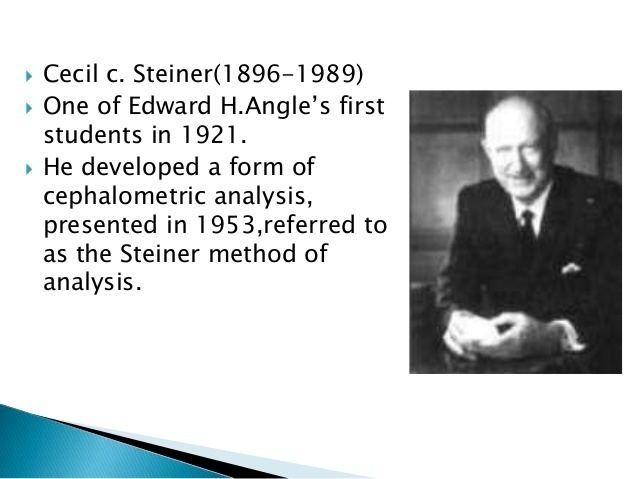Name Cecil Steiner | Role Dentist | |
 | ||
Died 1989, Longview, Washington, United States | ||
Cecil C. Steiner (June 6, 1896 – February 11, 1989) was a dentist and one of Edward H. Angle's first students in 1921. He developed a form of cephalometric analysis, presented in 1953, referred to as the Steiner method of analysis.
Contents
Life
He was born in Rancho Cucamonga, California. His father, Emil Steiner and him, moved to California during the Gold Rush years in 1904. They settled in Imperial Valley where he was part of a school with 12 students. His family homestead a farm in Brawley, California. He attended University of California, Berkeley for his undergraduate education. Dr. Steiner obtained his dental degree from UCSF School of Dentistry at the age of 19. Soon after, he started working in Los Angeles with local Orthodontist named Dr. Ray Robinson. Orthodontic schools at the time spent much time in re-cementing molar bands. He eventually went to Pasadena, California to meet and enroll himself in Angle School of Orthodontia. During the meeting, Dr. Edward Angle asked Steiner about Charles Darwin, which Steiner was not able to answer. Therefore, Steiner was dismissed from the meeting, but Anna Angle asked Steiner to read 20 books and asked him to return for another meeting with Dr. Angle. He returned for another meeting and eventually became Angle's second student in the school in Pasadena. He obtained his degree from there in 1921. He continued working with Angle after his graduation and worked on Ribbon Arch at the school.
Career
He is most-remember for his articles Cephalometrics for You and me (1953), Cephalometrics in Clinical Practice (1959), Use of Cephalometrics as an Aid to Planning and Assessing Orthodontic Treatment (1960). He worked at Angle School of Orthodontia and was also a part-time faculty at the Orthodontics Department in UCSF School of Dentistry. He was instrumental in starting USC Orthodontic Program with Larry L. Dougherty in 1960. The orthodontic department at USC dedicated their library to Dr. steiner due to his contributions to the school.
He died at the age of 92 in Longview, Washington.
Steiner's Analysis
Steiner's Analysis consists of Skeletal, Dental and Soft Tissue Analysis. The skeletal component tries to related the upper and lower to the skull and to each other. The dental component tries to relate the upper and lower incisors to each other and to their respective jaws and the soft tissue component tries to understand the lower facial profile.
